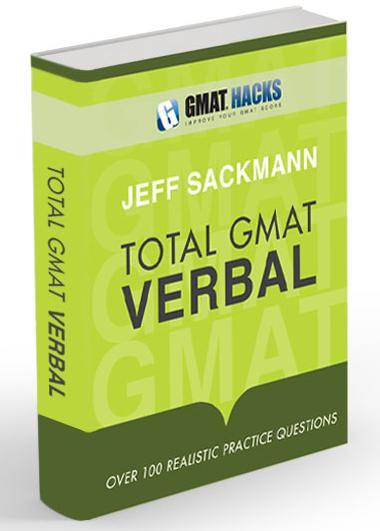
Bookshelf
|
|
Total GMAT Math Jeff's complete Quant guide, on sale now! |
|
|
Total GMAT Verbal Everything you need to ace GMAT Verbal! |
1,800 Practice Math Questions
Buy Jeff's books at Amazon.com

GMAT Official Guide, with IR
OG Math | OG Verbal
OG12 & Quant Rev solutions!
GMAT Question of the Day
Beginner's Guide to the GMAT
GMAT Hacks Affiliate Program

Recent Hacks

Categories
- General Study Tips
- Goals and Planning
- CAT Strategy
- The Mental Game
- GMAT Math Strategy
- GMAT Math Topics
- Mental Math
- Data Sufficiency
- Critical Reasoning
- Reading Comprehension
- Sentence Correction
- Analytical Writing Assessment
- Integrated Reasoning
- IR Explained
- Business School Admissions
- GMAT Prep Resources
- Practice Questions
- Total GMAT Math
- Total GMAT Verbal
- GMAT 111

GMAT Sentence Correction (Beginner's Guide)
| You should follow me on Twitter. While you're at it, take a moment to subscribe to GMAT Hacks via RSS or Email. |
Note: Today's article is the fourth in a series I'm running throughout January and February called "The Beginner's Guide to the GMAT." Here are parts one, two, and three.
Unlike GMAT Critical Reasoning and Reading Comprehension, which are familiar question types on many standardized tests, GMAT Sentence Correction is fairly unique. Instead of focusing on your understanding of content, it tests your ability to identify clearly, grammatically written sentences.
In large part, GMAT Sentence Correction is a grammar test. There are no items that explicitly ask about the names of verb tenses, and you're not required to diagram sentences, but those skills--if you have them already--will come in handy.
GMAT Sentence Correction Example
To get a feel for what you're up against, here's an example question:
Most of the purported health benefits of tea comes from antioxidants--compounds also found in beta carotene, vitamin E, and vitamin C that inhibit the formation of plaque along the body's blood vessels.
The five answer choices offer different ways of replacing the underlined portion of the sentence. Choice (A) is always exactly the same; it is the answer that says, "The sentence is correct as written."
Usually, there are patterns in the choices. In this example, (A) and (B) retain the word "comes" at the beginning of the underlined portion, while (C), (D), and (E) replace it with "come." Similarly, (A) and (D) keep "that" at the end, while (B) and (E) use "they" and (C) has "and."
One of the key strategies that will help you move through Sentence Correction questions more efficiently is to identify those patterns. Not only do they help you eliminate more than one answer quickly, but they also can help you identify mistakes in the first place, by seeing how groups of choices differ from each other.
Grammar Tested on GMAT Sentence Correction
There are several grammatical areas that come up frequently on Sentence Correction items:
- verb tenses
- subject/verb agreement
- modifiers
- comparisons and parallelism
- pronoun usage
- idioms
- clarity
The last two aren't really rules, and they can be the most complicated. For that reason, they should be among your last priorities. You will never learn all the idioms that the GMAT could test, and you'll probably never agree 100% with how the GMAT test-makers define clarity, so better to focus on the large chunk of Sentence Correction that is more straightforward.
Idioms
Especially if English is not your first language, idioms can be the most difficult part of Sentence Correction. As noted, you won't learn them all. It isn't even worth your time to try.
However, that doesn't mean you shouldn't learn any. As you go through practice questions, note those idioms that arise. There will be a couple dozen that are particularly common. If you learn those, you'll be able to handle most of the idioms you'll see on test day, and you won't have spent countless hours mastering obscure verb/preposition combinations that you won't see on the GMAT.
Difficult GMAT Sentence Correction Questions
There are a few ways that SC questions get harder:
- Sentences get longer.
- The underlined portion gets longer (sometimes including the entire sentence).
- The correct answer is less appealing.
Length is a challenge, especially since it makes patterns more difficult to spot. But with focus, longer sentences can usually be reduced to familiar problems.
The toughest problems are those where all five choices don't sound very good. While on some items, "clarity of expression" is the difference between a right answer and a wrong answer, there are other where none of the choices would pass the "clarity of expression" test.
Instead, on these questions, four of the questions will have unambiguous grammatical mistakes, and the fifth will not. Even if that fifth choice is wordy, or somewhat confusingly worded, it must be right: a grammatically incorrect sentence will always be wrong.
As with math, don't worry too much about difficult problems at the outset: there are plenty of fundamentals to learn, and you can get a long way toward your goal score by mastering the basics of GMAT Sentence Correction.
Finally, here is a table of contents of the articles I've previously written on GMAT Sentence Correction.
About the author: Jeff Sackmann has written many GMAT preparation books, including the popular Total GMAT Math, Total GMAT Verbal, and GMAT 111. He has also created explanations for problems in The Official Guide, as well as 1,800 practice GMAT math questions.
 |
Total GMAT Verbal
The comprehensive guide to the GMAT Verbal section. Recognize, dissect, and master every question type
you'll face on the test. Everything you need, all in one place, including 100+ realistic practice questions. |